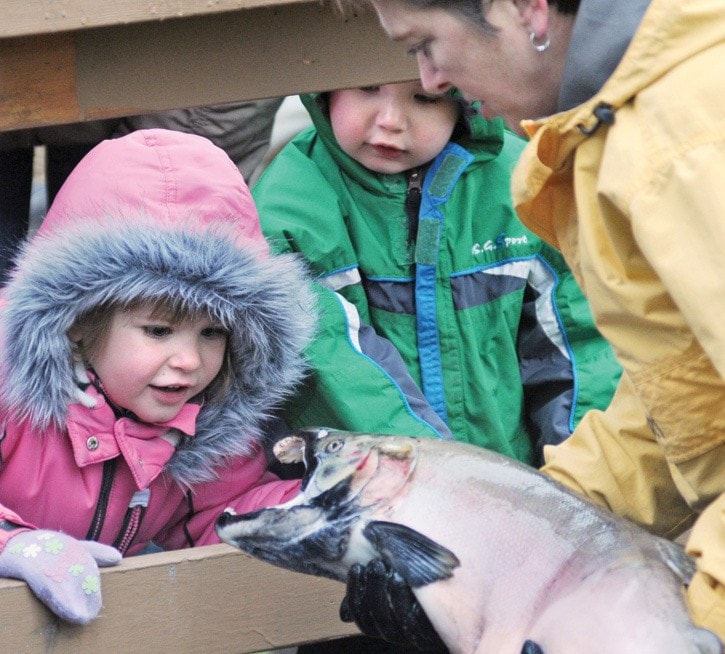More than just Coho thrive in the Colquitz River.
Perch, sticklebacks, sculpin, crayfish, fairy shrimp, Olympia oysters, Great Blue Herons, countless species of insects, and cutthroat trout, the latter of which is already at risk of endangerment, also call this urban watershed home throughout the year.
And while the Coho have returned to spawn in the upper Colquitz since upwards of 1,000 litres of home heating oil leaked into the river last week, concerns remain about what effects the hazardous material will have on the environment in the long run.
“I look at this from a fish perspective, but we can’t just look at it like that. Healthy fish are an indicator of a healthy creek,” said Chris Bos, who volunteers to monitor the Coho in the creek. “I don’t want to say: ‘There’s no oil. The fish aren’t dying, so the whole system’s fine,’ and in a year from now we see the whole system’s collapsed because we lost all the insects.”
Bos helps run the counting fence in Cuthbert Holmes Park. The fence was removed during the spill and will remain gone for the rest of the salmon run season.
Prior to the spill, Bos said the number of returning fish was almost above average, so “we’re not in bad shape for the year.”
Though 25 dead fish were found at the fence and have been linked to the spill, more salmon may have died downstream closer to Portage Inlet. Bos says two dozen dead fish won’t devastate the whole run.
“In the spring it will be vital that we put in that juvenile counting fence and count the juveniles going out (to the ocean). Given that we put through about 250 fish, you should be seeing something in the region 10 times or 20 times or 30 times that,” he said. “That’s a real, accurate way of being able to identify what the damage is on the creek.”
When an oil spill happens, “the most significant impact is going to be at the time of the initial release,” said Graham Knox, manager of the Ministry of Environment’s Environmental Emergency Program.
Part of Knox’s role has been liaising with Saanich public works crews to ensure booms and absorbent pads are installed properly and strategically to collect as much of the oil as possible.
As well, Saanich was asked to do a camera survey of the outflow pipeline in the Glanford and McKenzie avenues area to ensure stranded oil isn’t released during the next rainfall.
“(Local governments are) a critical player in making sure we find the leak or do everything we can to find it, take appropriate actions to ensure it’s contained and then cleaned up,” Knox said. “We’re very happy with the steps Saanich has taken.”
The focus now, Bos says, is determining how this can be prevented in the future.
“This is not ever going to be the only problem. We’ve seen it happen on the Colquitz before. Between us we can all do better,” he said, saying Saanich residents and all three levels of government can do more. “If we’re still seeing oil getting in the creek, then that is something we can improve on.”
The Kenneth Street homeowners whose oil tank leaked could face a hefty bill to pay for the cleanup efforts.
Knox says he’s seen other similar spills cost hundreds of thousands of dollars.
“The prevention work of ensuring your tanks are looked at and maintained regularly, or looking at alternatives that are safer, that’s something every homeowner should consider if they have tanks and want to protect themselves from future liabilities,” Knox said. “My focus is working with the spiller, especially in cases like this when it was not an intentional release, to contain the spill and do what’s necessary to prevent further damage.”
Erika Bennett, communications officer with the Insurance Bureau of Canada, says once oil leaks off the policyholder’s property, third-party liability kicks in to help pay for the cleanup.
“Third-party liability should cover it, up to whatever the limits are in the policy that person bought,” she said.
If it’s subsequently determined that a homeowner does not properly maintain their leaky tank, insurance companies can seek to recoup the expenses paid out through subrogation, Bennett added.
According to a Saanich-distributed fact sheet on home heating oil tanks, “A big cleanup could cost more than your home is worth, and the full cost may not be covered by your household insurance.”
The fact sheet says most insurance companies will not provide new homeowner coverage if an above-ground tank is more than 15 years old, and many won’t provide policies for homes with underground tanks.
The complete fact sheet, including how to properly maintain your oil tank, can be downloaded at saanich.ca/living/environment/pdf/otank.pdf.
kslavin@saanichnews.com
